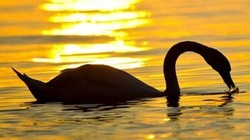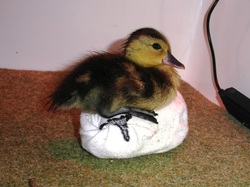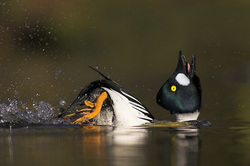
The safety tens of thousands of swans and geese in the UK could be improved by new research into collisions with power lines, which started this week with the installation of more than 150 special bird diverters in Lancashire.
Flying collisions are the most commonly recorded cause of death for swans, whose size means they have poor manoeuvrability in flight. Bird diverters are special attachments to the lines that help make them stand out to birds in flight. For the first time, a partnership between Electricity North West, Lancaster University and the Wildfowl & Wetlands Trust (WWT) is studying the efficiency of different types of diverter, alongside agricultural, weather and landscape factors that affect birds' flights. The study area around WWT Martin Mere in Lancashire is the winter home of 30,000 Pink-footed Geese and 2,500 Whooper Swans and has been identified as a sensitive area for collisions.
Dr Eileen Rees, Head of UK Waterbird Conservation for WWT, said: "Tens of thousands of migratory geese and swans make the UK's wetlands their winter homes. Collisions with power lines are a major cause of death for them, so WWT is delighted to be working with Electricity North West to make Lancashire, and the UK as a whole, a safer place for them. Through this innovative partnership we aim to gather evidence for solutions that work in our modern landscape. As well as reducing the risk to swans and geese, the results of the study should help electricity suppliers throughout the UK provide their service with fewer unnecessary interruptions."
Steve Cox, future network manager for Electricity North West, added: "We hope that the diverters and our subsequent research will go on to help birds and electricity customers across the UK. By working closely with WWT Martin Mere we discovered this was a sensitive section of the network as it was located in a known flight path and we are delighted to be able to help protect these wonderful birds. By limiting the chances of any collisions, the special diverters will also reduce any possible impact on customer power supplies."
Dr Ian Hartley, a Senior Lecturer at the Lancaster Environment Centre at Lancaster University and a behavioural ecology expert, commented: "This is a great opportunity and we are very pleased to be working with new partners on a project of such high calibre which is going to have a large impact on the area around where the geese and swans winter. One of our Master's students will work on the project for a year and our input will be to add knowledge on the analysis and geographic information systems aspects."
Throughout this winter, the study will closely observe the flight behaviour of geese and swans in and around WWT Martin Mere Wetland Centre. It will determine the importance of features such as tree lines, the choice of crops and the wind direction on the birds' choice of flight line and height.
For more information about Electricity North West please visit www.enwl.co.uk, and for further information about WWT see www.wwt.org.uk.
Flying collisions are the most commonly recorded cause of death for swans, whose size means they have poor manoeuvrability in flight. Bird diverters are special attachments to the lines that help make them stand out to birds in flight. For the first time, a partnership between Electricity North West, Lancaster University and the Wildfowl & Wetlands Trust (WWT) is studying the efficiency of different types of diverter, alongside agricultural, weather and landscape factors that affect birds' flights. The study area around WWT Martin Mere in Lancashire is the winter home of 30,000 Pink-footed Geese and 2,500 Whooper Swans and has been identified as a sensitive area for collisions.
Dr Eileen Rees, Head of UK Waterbird Conservation for WWT, said: "Tens of thousands of migratory geese and swans make the UK's wetlands their winter homes. Collisions with power lines are a major cause of death for them, so WWT is delighted to be working with Electricity North West to make Lancashire, and the UK as a whole, a safer place for them. Through this innovative partnership we aim to gather evidence for solutions that work in our modern landscape. As well as reducing the risk to swans and geese, the results of the study should help electricity suppliers throughout the UK provide their service with fewer unnecessary interruptions."
Steve Cox, future network manager for Electricity North West, added: "We hope that the diverters and our subsequent research will go on to help birds and electricity customers across the UK. By working closely with WWT Martin Mere we discovered this was a sensitive section of the network as it was located in a known flight path and we are delighted to be able to help protect these wonderful birds. By limiting the chances of any collisions, the special diverters will also reduce any possible impact on customer power supplies."
Dr Ian Hartley, a Senior Lecturer at the Lancaster Environment Centre at Lancaster University and a behavioural ecology expert, commented: "This is a great opportunity and we are very pleased to be working with new partners on a project of such high calibre which is going to have a large impact on the area around where the geese and swans winter. One of our Master's students will work on the project for a year and our input will be to add knowledge on the analysis and geographic information systems aspects."
Throughout this winter, the study will closely observe the flight behaviour of geese and swans in and around WWT Martin Mere Wetland Centre. It will determine the importance of features such as tree lines, the choice of crops and the wind direction on the birds' choice of flight line and height.
For more information about Electricity North West please visit www.enwl.co.uk, and for further information about WWT see www.wwt.org.uk.



 RSS Feed
RSS Feed